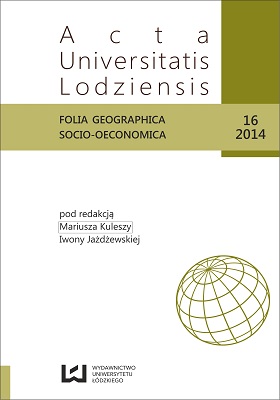Transformations of the post-fortified areas on the example of Toruń according to the M.R.G. Conzen theory
DOI:
https://doi.org/10.18778/1508-1117.16.04Keywords:
urban morphology, fortifications of cities, transformation of urban spatial structure, fringe belt concept, ToruńAbstract
The development of the former fortification zones in the urban landscape of European cities includes usually the representational institutional buildings and areas of public functions. It provides a clear zone which is a testimony of the power of the old historic towns, but also it emphasizes separateness of post-fortification areas in the urban spatial structure. At the same time the post-fortification development creates an extension of the old town and provides a recreation zone for urban residents. Transformations of former fortifications zone in Toruń led to the creation of the urban landscape, which can be compared to many European cities. In the paper, on the background of the development of modern bastion fortifications in Europe and Poland, the characteristics of the development of the city’s fortifications in Toruń was made (right bank part), as well as analysis of their subsequent transformation and development in the context of the concept of fringe belt by M.R.G. Conzen.
References
Bartz D., Żelska M., 1977, Ewolucja przestrzenno-funkcjonalna Bydgoskiego Przedmieścia do 1975, „Rocznik Toruński”, 12, s. 37−55.
Google Scholar
Biskup M. (red.), 2003, Historia Torunia. W czasach zaboru pruskiego (1793‒1920), t. III, cz. I, Toruń.
Google Scholar
Bogdanowski J., 2002, Architektura obronna w krajobrazie Polski. Od Biskupina po Westerplatte, PWN, Warszawa‒Kraków
Google Scholar
Conzen M.R.G., 1960, Alnwick, Northumberland: a Study in Town-Plan Analysis, Publication, 27, Institute of British Geographers, London
Google Scholar
DOI: https://doi.org/10.2307/621094
Conzen M.R.G., 1962, The plan analysis of an English city centre, [w:] Norborg K. (red.), Proceedings of the IGU Symposium in Urban Geography, Gleerup, Lund, s. 383−414.
Google Scholar
Conzen M.R.G., 1969, Glossary of technical terms’ in ‘Alnwick, Northumberland: a study in town-plan analysis, Publications 27 (2nd ed.), Institute of British Geographers, s. 123−131
Google Scholar
Conzen M.R.G., 2004, Thinking about Urban Form: Papers on Urban Morphology, 1932–1998, Peter Lang, Oxford.
Google Scholar
Duffy C., 1979, Siege warfare: the fortress in the early modern world, 1494‒1660, Routledge and Kegan Paul, London.
Google Scholar
Dybaś B., 1998, Fortece Rzeczypospolitej. Studium z dziejów budowy fortyfikacji stałych w państwie polsko-litewskim w XVII wieku, Toruń
Google Scholar
Jarczewska M., 2000, Szata roślinna Promenady wrocławskiej w okresie jej świetności i obecnie, [w:] Mitkowska A. (red.), Roślinność miast historycznych (ogrody i parki o strukturalnym znaczeniu dla układów urbanistycznych), Materiały z V konferencji naukowej, Kraków
Google Scholar
Klein F., 1914, Planty krakowskie, Towarzystwo Ochrony Piękności Miasta i Okolicy, Kraków, s. 18.
Google Scholar
Klupsz L., 2006, Miejsce fortyfikacji we współczesnych aglomeracjach, [w:] Wilkaniec A., Wichrowski M. (red.), Fortyfikacje w przestrzeni miasta, Wydawnictwo Akademii Rolniczej im. Augusta Cieszkowskiego, Poznań.
Google Scholar
Krajnik D., Šćitaroci M.O., Šćitaroci B.B.O., 2008, City fortifications and the form of European cities, with special reference to Croatia, „Urban Morphology”, 12(2).
Google Scholar
DOI: https://doi.org/10.51347/jum.v12i2.3944
Kristjánsdóttir S., 2001, The integration of architectural and geographical concepts in urbanmorphology: preliminary thoughts, [w:] Scheer B.C. (red.), Proceedings of the International Seminar on Urban Form, Cincinnati, Ohio, s. 113‒115.
Google Scholar
Narębski L., 2004, Forteczny Park Kulturowy Twierdzy Toruń szansą na ochronę obszarową fortyfikacji toruńskich, [w:] Fortyfikacja europejskim dziedzictwem kultury. Forteczne parki kulturowe szansą na ochronę zabytków architektury obronnej, Materiały z konferencji naukowej, Świnoujście 8‒10 października 2004, Warszawa.
Google Scholar
Rohrscheidt v. A.M., 2009, Polska: największe muzeum fortyfikacji na wolnym powietrzu w aspekcie rozwoju turystyki kulturowej, „Turystyka Kulturowa”, 2
Google Scholar
Skrzyńska A., 2006, Fortyfikacje w przestrzeni miasta – sukcesja funkcji w układach przestrzennych, [w:] Wilkaniec A., Wichrowski M. (red.), Fortyfikacje w przestrzeni miasta, Wydawnictwo Akademii Rolniczej im. Augusta Cieszkowskiego, Poznań
Google Scholar
Whitehand J.W.R., 1987, The Changing Face of Cities: A Study of Development Cycles and Urban Form, Institute of British Geographers, Special Publication 21, Blackwell, Oxford, s. 76−94
Google Scholar
Whitehand J.W.R., 1988, Urban fringe belts: development of an idea, „Planning Perspectives”, 3, s. 47−58
Google Scholar
DOI: https://doi.org/10.1080/02665438808725651
Whitehand J.W.R., 2001, British urban morphology: the Conzenian tradition, „Urban Morphology”, 5, s. 103‒109.
Google Scholar
DOI: https://doi.org/10.51347/jum.v5i2.3896
Whitehand J.W.R., Morton N.J., 2006, The fringe-belt phenomenon and socio-economic Change, „Urban Studies”, 43(11), s. 2047‒2066.
Google Scholar
DOI: https://doi.org/10.1080/00420980600945138
Wilkaniec A., Wichrowski M. (red.), 2006, Fortyfikacje w przestrzeni miasta, Wydawnictwo Akademii Rolniczej im. Augusta Cieszkowskiego, Poznań
Google Scholar
Downloads
Published
How to Cite
Issue
Section
License

This work is licensed under a Creative Commons Attribution-NonCommercial-NoDerivatives 4.0 International License.








